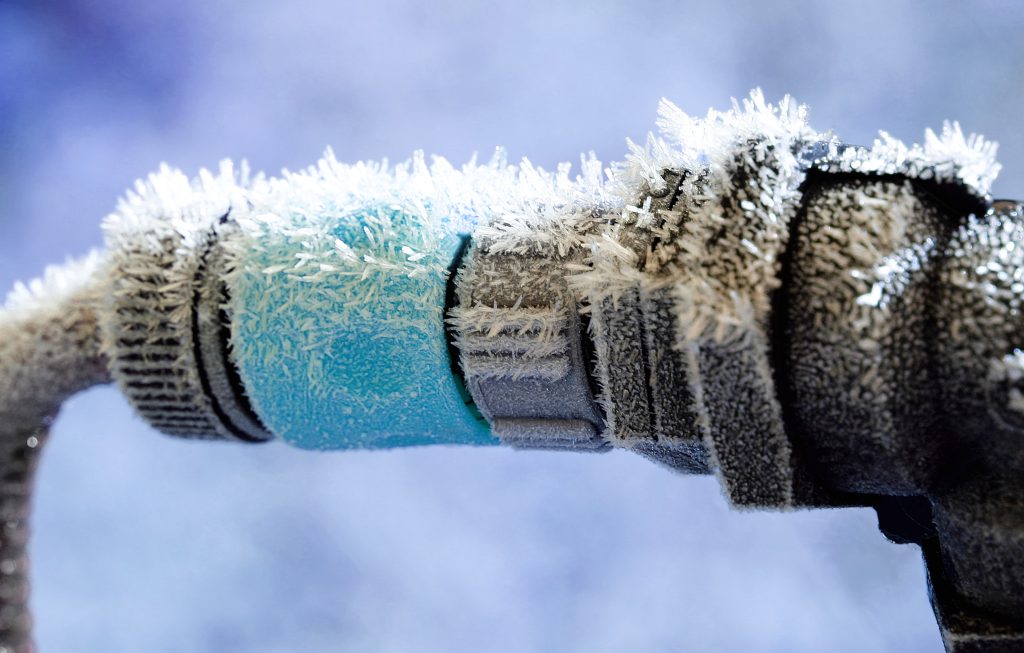
Freezing pipes in the winter is every homeowner’s worst nightmare! Not only do they avert steady water flow, but they also increase the odds of severe plumbing emergencies.
However, acting quickly to address this situation can save hassle and costly repairs while preventing major water damage to your home. Additionally, take proactive steps to winterize your pipes and enjoy winters worry-free. Let’s dive in to learn what to do if pipes freeze and the preemptive measures to avoid it from reoccurring.
Understanding Frozen Pipes
• What Causes Pipes to Freeze
Recognizing the red flags of frozen pipes is vital for effectively preventing and resolving this pervasive winter plumbing issue. Here are the factors leading to frozen winter pipes:
◦ Low Temperatures
Frozen pipes are prevalent in cold weather. When temperatures fall below freezing (32°F or 0°C), the water in your pipe will also freeze. It’s notably true for pipes in cold or poorly insulated regions like basements, attics, crawl spaces, and exterior walls.
◦ Insufficient Insulation
If your pipes aren’t appropriately insulated or exposed to cold air, they are likely to freeze when temperatures drop. Without adequate insulation, the water inside the pipe can quickly freeze, resulting in little to no water flow.
◦ Exterior Openings
Cracks, gaps, or openings in your home’s exterior can let cold air in and reach your pipes. You can typically notice this around windows, doors, vents, and utility penetrations. Don’t underestimate minor gaps, as they can lead to considerable heat loss and increase the likelihood of pipes freezing.
◦ Poorly Heated Areas
Garages, crawl spaces, and storage places are particularly vulnerable to frozen pipes. These places may not be warm enough to protect the pipes from freezing, especially during protracted cold spells.
◦ Outer Pipes
Outdoor pipes, like those connected to outdoor faucets, sprinkler systems, and swimming pool supply lines, are at higher risk of freezing. Since they are consistently exposed to the outer elements, they are more prone to freeze, especially if you haven’t made them winter-ready by insulation and draining them.
◦ Thermostat Settings
Setting your thermostat too low, notably if you’re away from home or on vacation, might raise the possibility of pipes freezing. Maintaining a stable inside temperature, even while the house is vacant, can assist in keeping pipes from freezing.
• Consequences of Frozen Pipes
◦ Burst Pipes
The most apparent and significant effect of freezing pipes is bursting. A burst pipe may inflict gallons of water into your house, severely damaging the walls, flooring, and furniture. Additionally, the inconvenience of dealing with water restoration and repair can further overwhelm the situation. In such instances, it’s best to let the expert plumbers in Sacramento handle the situation.
◦ Disrupted Water Supply
Even if your pipes do not burst, freezing can cause disruptions in your water supply. Frozen pipes impede water flow, preventing you from using vital utilities such as showers, toilets, and sinks.
◦ Property Damage
Beyond the water damage caused by broken pipes, frozen pipes can trigger structural damage to your property. Water seeping into walls, ceilings, and floors can compromise your property’s structural integrity, resulting in pricey repairs.
◦ Mold Development
Where there’s moisture, mold & mildew will probably develop. If water from frozen pipes isn’t addressed immediately, it can serve as an ideal breeding ground for this deadly fungus to thrive. Mold and mildew not only cause damage to your house, but they also pose major health hazards to you and your family.
Dealing with Frozen Pipes
Sometimes, pips can still freeze despite your best efforts. If you detect a water pipe freezing in your house, don’t fret! Here’s what you can do to thaw frozen pipes:
• Shut off the Water Supply
First and foremost, turn off the main water supply to avert further damage, like pipe bursting. While the location of the main shut-off valve may vary depending on your area and the style of your home, you can find it probably in the utility room, crawl space, basement, or near the meter. Also, once you locate it, consider painting the valve with some bright color to facilitate its search in an emergency. Alternatively, you can call San Jose plumbers to assist you and resolve the issue.
• Locate the Frozen Pipe
With the water turned off, attempt to locate the frozen pipe in your residence. Inspect the pipes in your basement, crawl space, and attic. It’s also vital to examine any exterior pipes and those within cabinets, like under your sink. You can identify a frozen pipe by observing frost on the outside.
• Keep Faucets Open
Once the pipe has thawed, open the faucets to allow water to flow. It can reduce pressure and avoid pipe bursts.
• Apply Heat
Use a hairdryer, heat lamp, or space heater to heat the frozen pipe gently. Never use open flames or electrical equipment near water to avoid fire or electrocution.
• Thaw Pipes Slowly
Patience is a must while thawing frozen pipes. Avoid rapidly applying excessive heat as it may cause rapid expansion and damage to the pipes.
• Call a Professional
If you’re unable to defrost the pipes yourself or fear a burst pipe, it is time to engage seasoned plumbers in Modesto. Experts have the knowledge, necessary tools, and skills to thaw frozen pipes safely and perform any required repairs.
Preventing Frozen Pipes
Now that we’ve understood the frozen pipes, including their dire ramifications and troubleshooting tips. Let’s focus on prevention. As the adage, “An ounce of prevention is worth a pound of cure.” Here are some actions you can do to keep your pipes from freezing.
• Insulate Pipes
Insulation is your best protection against frozen pipes. Insulate exposed pipes in unheated places, including basements, attics, and crawl spaces. Put towels or blankets around the pipes or use foam insulation sleeves for extra protection.
• Seal Cracks and Gaps
Cold air may penetrate your home through cracks and holes in walls, windows, and doors, making your pipe susceptible to freezing. Consider sealing these holes with caulk or weatherstripping to keep the cold out and the heat in.
• Keep Interior Temperatures Consistent
Maintain a steady temperature within your home, particularly during cold spells. Set your thermostat to at least 55°F (12°C) even when you’re away to keep your pipes from freezing.
• Let Faucets Drip
When temperatures dip below freezing, let faucets drip slightly to keep water flowing through the pipes. Moving water is less prone to freeze, which lowers the danger of pipe damage.
• Disconnect Garden Hoses
Disconnect and drain exterior hoses before the first frost to prevent water from freezing and causing damage to the pipes.
Final Thoughts
Frozen pipes are more than merely a winter nuisance—they’re a homeowner’s worst nightmare. From burst pipes to property damage, the consequences of frozen pipes can be devastating. But with proper prevention and prompt action, you can protect your home and keep pipes from freezing. Remember, when it comes to frozen pipes, prevention is essential. Consult professionals as soon as you detect the issue to safeguard your home against frozen pipe disasters.


 Request a Service
Request a Service